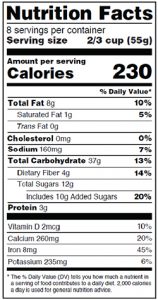Sometimes even the most mundane of activities can be overwhelming- including grocery shopping. Grocery shopping can be especially overwhelming when you are trying to maintain a healthy diet. It seems like we see buzz words such as, “all-natural” and “sugar free” on every other item in the store, but words like these don’t actually make something healthy. Checkout three of my best tips on how to make sure you are getting your money’s worth when shopping for healthy foods.
Nutrition, Nutrition, Nutrition
One of the easiest ways to identify if a food is genuinely healthy, is to read the often overlooked, yet unequivocally useful nutrition facts. The very first thing you will see when looking at the nutrition facts is the serving size- a tool often used by food manufacturers to make their food appear healthier. Often, the serving size is decreased, and the number of servings increased, so the food seems healthier. But just remember, the more servings you consume, the more calories, fats, sugars, carbs and sodium you are eating.
Another important thing to pay attention to when perusing the nutrition facts is the ingredients list. You may think you know exactly what is in your food, but you will be surprised by what you are actually consuming. The rule of thumb is; if you can’t pronounce it, you shouldn’t be eating it. For example; butylated hydroxyanisole, more commonly known as BHA, is an ingredient commonly used in foods to help prevent spoilage, however it has also been known to lead to cancer, according to The Huffington Post. Remember to always be observant of what you are actually putting in your body- after all, you only get one body and you should take good care of it.
Classification Symbols
Another easy way to identify healthy foods when you are shopping in a grocery store is to look for food classification symbols. Some of the most well known classification symbols are the USDA Organic, Non-GMO project, and American Grassfed. Although having a certification like those listed does not inherently make a food healthy, certifications like these can help you quickly identify which foods have been deemed to have healthy qualities.
Know Your Fruits and Vegetables
Everyone knows that fruits and vegetables are extremely important to leading a healthy lifestyle. But what a lot of people don’t know is how to determine if your food is ripe or not. Nobody wants to waste money on an expensive bundle of organic bananas only to get home, peel one open, and discover upon first bite that it is mushy and over ripened. There are many easy tricks to help you tell if your produce is ripe or not. For instance, you can tell if a banana is ripe by the color of the peel. One of my favorites summertime snacks is a ripe, juicy watermelon- and the best way to tell if a watermelon is ripe is by knocking on it and hoping it sounds ripe. Check out this website
 to find out more information about checking the ripeness of your produce.
to find out more information about checking the ripeness of your produce.



